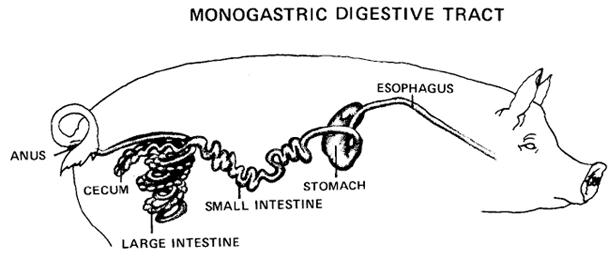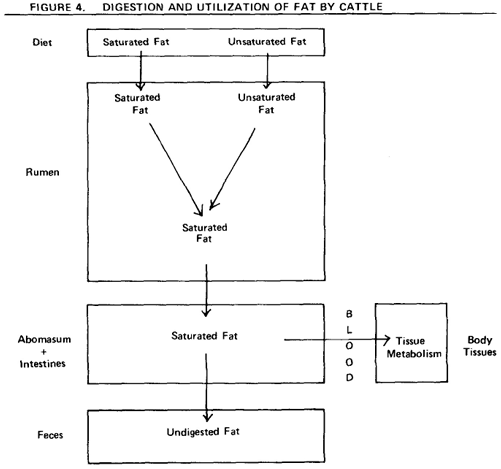Whitney Rounds and Dennis B. Herd
Download PDF | Email for Questions
Digestive Tract Anatomy | Rumen Fermentation | Food Passage | Advantages and Disadvantages
Digestion in cattle is similar to digestion in man and certain other animals, except that, in cattle, foods are first subjected to microbial fermentation in the reticulo-rumen. Cattle can utilize roughages and other fiberous feedstuffs only through the action of microorganisms which are normally ingested on feed or obtained from other animals. Microorganisms in the rumen have the unique ability to break down fiberous feedstuffs to obtain the simple nutrients required for their growth. In this process, various microbial by-products of no value to the microbe, such as volatile fatty acids and B vitamins, are produced. These by-products are absorbed into the blood and are used as sources of nutrients by the animal. The microorganisms also pass from the rumen to the lower digestive tract, where the are digested and their constituent protein, vitamins and other nutrients are absorbed and utilized by the animal. The relationship of the microbes wiht the host cow is mutually beneficial.
Digestive Tract Anatomy
Man, dogs, poultry and swine have simple or monogastric stomachs (see Figure 1). The monogastric stomach is a pouch-like structure containing glands which secrete hydrochloric acid and digestive enzymes. Monogastric animals do not produce enzymes capable of breaking down cellulose, the main source of energy in forages. Forage consuming species, such as cattle and sheep, have intestinal differences which enable them to digest large amounts of fiberous material. In cattle and sheep, rumen microbes supply the digestive enzymes necessary for the breakdown of plant cellulose and hemicellulose. The cow has the stomach volume and properties necessary to assist with the microbial digestion. The ruminant digestive tract and the ruminant stomach are shown in Figure 1.
The ruminant stomach is divided into four compartments: the rumen, reticulum, omasum and abomasum. Digesta can flow freely between the first two compartments, the rumen and reticulum. The reticulo-rumen contains more than 30 percent of the total digestive tract capacity and most of the microbial activity takes place here. After sufficient time in the reticulo-rumen, digesta flows into the omasum. The omasum has many folds of tissue, similar to a partially open book, and contains from 6 to 8 percent of the total digestive tract capacity. The omasum is thought to aid in the reabsorption of water form digesta flowing through it, and to assist in reducing particle size. Upon leaving the omasum, digesta passes into the abomasum, which is frequently referred to as the true stomach. Like the stomach of monogastric animals, the abomasum secretes digestive enzymes which prepare digesta for absorption in the small intestines. Approximately 6 to 8 percent of the total digestive tract is taken up by the abomasum.
Feeds broken down to their component parts during passage through the ruminant stomach are largely absorbed in the small intestines. Absorption of protein, vitamins, simple carbohydrates, fats and amino acids takes place here. Undigestable material which will not be absorbed passes into the large intestines, where excess moisture is reabsorbed and form is given to what will become the fecal droppings.
Rumen Fermentation
Fermentation in the rumen is made possible by a very stable environment for microbial growth. The normal pH ranges from 5.5 to 7.0, temperature ranges from 37 to 40 degrees centigrade. And food is continuously available in the rumen of properly fed animals. End products of fermentation are continuously removed, either by eructation, by absorption across the rumen wall or by passage out of the rumen to the lower digestive tract. Feed does not just “sit” in the rumen. There is continuous mixing of rumen contents as digestive tract muscles contract. The mixing action helps expose food to microbial action and pass digesta through the system.
Rumen Microbes. Rumen bacteria have been classified according to the type of food they utilize or the end products they producee. Included are bacteria which digest cellulose, hemicellulose, starch, sugar, organic acids, protein and fat, as well as bacteria which produce ammonia or methane or synthesize vitamins.
Protozoa found in the rumen are larger than bacteria, and are classified according to cell morphology. Protozoa species are known to vary with the type of diet, time of year and geological location. Protozoa have been known to consume rumen bacteria. Bacteria and protozoa have food value to the cow. Dried microbes contain from 40 to 50 percent crude protein which is over 75 percent digestible.
Microbial Metabolism. Microbes in the cow’s digestive tract use a portion of the nitrogen and energy from the feed for their own growth and reproduction. As they grow, microbes manufacture microbial protein and store energy in their cells. Microbes themselves become an important source of food (particularly protein) for the cow. During fermentation the microbial population converts a large portion of the feed carbohydrates (sugars, starches, cellulose and hemicelloses) to volatile fatty acids which are the cow’s main source of energy (Figure 3).
The composition of the volatile fatty acids produced in the rumen varies according to the different rations fed. Normally, acetic acid would make up 60 percent, propionic 22 percent and butyric 16 percent of the total acid production. In general, high roughage rations will contain a higher percentage of acetic acid whereas high concentrate rations will result in slightly higher levels of propionic acid. Ideally, decreasing acetic and butyric acids and increasing propionic would lead to more efficient beef production. However, high acetate levels are desired for milk fat production. High grain to roughage ratios, some feed processing techniques and certain feed additives promote propionate at the expense of acetate.
Food Passage
Food Passage through the Digestive Tract
The time required for food passage through the digestive tract ranges from 1 to 3 days depending upon characteristics of the food and the specific nutritient involved.
In the mouth, chewing breaks the food into smaller particles. Digestive enzymes in saliva are mixed with food before it passes down the esophagus into the reticulo-rumen (Figure 1). Although most of the feed undergoes fermentation, small amounts may pass unchanged through the rumen into the omasum and abomausm. Some of the larger food particles will be regurgitated, chewed again and reswallowed. This “chewing of the cud” is important becuase cattle do not initially chew their food to the extent that monogastrics do.
Protein. Protein in the diet is subjected to degradation (partial or extensive) by ruminal microorganisms (Figure 2). Microbes degrade plant proteins to various degrees and use the resulting ammonia in the synthesis of microbial protein. The extent of protein degradation varies with the type and solubility of the protein. This degradation and resynthesis process has advantages and disadvantages. Some high quality proteins may be degraded, thus reducing the quantity of essential amino acids available to the animal. (Heat and acid treatment to reduce protein solubility are currently being studied as methods of preventing degradation, thus saving the amino acids for use by the animal.) On the other hand, extremely low quality plant proteins may be upgraded during digestions to a higher quality microbial protein. Plant proteins not degraded in the rumen along with microbial protein are passed to the lower tract. Digestive enzymes secreted in the abomasum break both plant and microbial protein into their component amino acids which are absorbed from the small intestines.
Non-Protein Nitrogen can be used as a substitute for plant nitrogen. Rumen microbes can use the non-protein nitrogen. Rumen microbes can use the non-protein nitrogen in the synthesis of microbial protein.
Carbohydrates. Carbohydrates in the diet also are degraded by rumen microorganisms (Figure 3). Volatile fatty acids and gases (methane and carbon dioxide) are the end products of this process. Volatile fatty acids produced by rumen microbes are absorbed directly form the rumen. Gases are eliminated through eructation.
Fiber, a complex carbohydrate, is composed of lignin, cellulose and hemicellulose. Lignin is very resistant to microbial attack, therefore little of it is digested. Cellulose is more readily digested than lignin, and hemicellulose is the most digestible of the three. Starches and sugars also are readily converted to acids and gases. Unfermented feed residues and microbial cells are left to pass through the omasum to the abomasum. In the abomasum, the secretion of digestive enzymes prepares the foodstuffs for absorption in the small intestine.
Fats. Some hydrogenation (addition of hydrogen) of unsaturated acids takes place in the rumen (Figure 4). Unsaturated dietary fat (soft fat) subjected to microbial action in the rumen is transformed to a hard or a saturated fat. Most fats are passed to the abomasum and small intestine where absorption occurs.
Advantages and Disadvantages
Advantage of Rumen Fermentation
Fermentation by the rumen microorganisms give the ruminant animal several unique capabilities:
1. Forage Utilization
Forage and roughage account for a large quantity of the total world feed resources. Rumen microorganisms, through the production of enzymes, allow the ruminant animal to use the fiberous portion of these roughages as an energy source.
2. Non-protein Nitrogen Utilization
Rumen microorganisms can manufacture protein form non-protein nitrogen. This microbial protein is later digested and supplies the animal with needed amino acids. Nonruminants must obtain essential amino acids directly form their diets.
3. Vitamin Synthesis
Rumen microorganisms can sythesize the B-complex vitamins and vitamin K. Dietary supplementation is not required, except in sick animals where rumen function is impaired.
Disadvantages of Rumen Fermentation
Fermentation in the rumen and reticulum may cause inefficient conversions of dietary constituents:
1. Waste Gas Production
Carbon dioxide and methane are by-products of the breakdown of carbohydrates, and are eliminated from the rumen. Sugars and starches would be of more benefit if they could be passed to the lower digestive tract for absorption as sugar.
2. Wasted Protein and Nitrogen
Ammonia and organic acids are the end result of protein breakdown. Some of the resulting ammonia is recombined to form microbial protein. However, under some conditions ammonia is lost, absorbed across the rumen wall and excreted in the urine. The loss of ammonia in the digestive process is inefficient.
3. Heat of Fermentation
Rumen microbes breaking down feedstuffs and reforming them generate heat. This heat of fermentation is a disadvantage in most instances. In cold environments, however, this heat will help meet the animal’s maintenance energy requirement.
4. Digestive Disturbances
Bloat and acidosis are cases of rumen malfunciton. Bloat results when fermentation gases are produced faster than they can be disposed of. Acidosis is the result of an excessive breakdown of readily available carbohydrates. In feedlot cattle, acidosis usually leads to an erosion of the rumen wall and liver abscesses.
The ruminant animal is unique because of the mutually beneficial symbiotic relationship that exists with the microbes living in its digestive tract. Through the action of these microbes, high-fiber feed sources become assets. Non-protein nitrogen compounds can be used by the ruminant in the production of microbial protein. Animals with simple stomachs cannot use cellulose or non-protein nitrogen.






